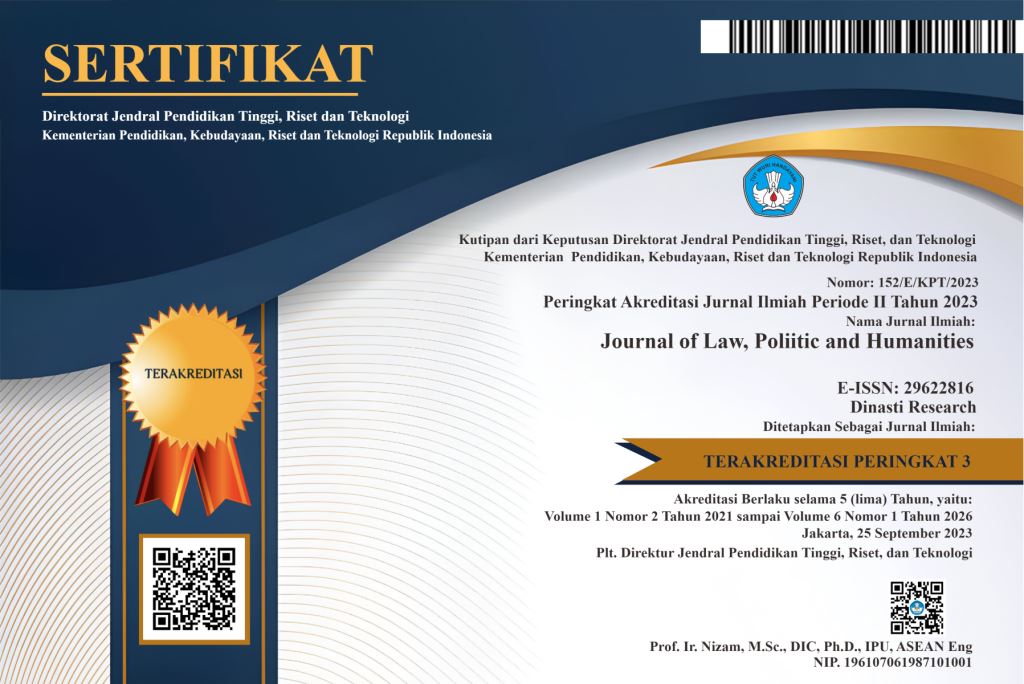Analysis the Supreme Court Decision and the Constitutional Court Decision Regarding the Age Limit for Regional Head Candidates
DOI:
https://doi.org/10.38035/jlph.v5i3.1316Keywords:
Constitutional Court , Supreme Court , Testing of Laws and Regulations , Age Limit for Regional Head CandidatesAbstract
This study purpose to analyze a decision made by Constitutional Court Number 70/PUU-XXII/2024 and the decision made by Supreme Court Number 23 P/HUM/2024 Relate to the age limit for a region head candidates. In the context of the hierarchy of norms in Indonesia, the dualism of authority to examine laws and regulations by the Supreme Court and the Constitutional Court often leads to conflicts of substance. The study used in this research is a type of normative juridical research method by approaching the law and case studies to assess whether there is a conflict of norms and legal vacuum. The results show that there are differences in interpretation between the two institutions regarding the minimum age of candidates for regional heads, which has an impact on legal uncertainty. To overcome this problem, it is necessary to reform the mechanism for testing statutory instruments, including the proposal for a single test at the Constitutional Court or the addition of norms to the Supreme Court Law regarding the validity of decisions in the event of changes in statutory norms. Research with the title analysis of this is expected to be a contribution to the optimization of the legal system in Indonesia.
References
M. (2017). HUKUM TATA NEGARA INDONESIA. Setara Press.
Hadi, F. (2022). Negara Hukum Dan Hak Asasi Manusia Di Indonesia. Wijaya Putra Law Review, 1(2).
Isra, S. (2015). Titik Singgung Wewenang Mahkamah Agung Dengan Mahkamah Konstitusi. Jurnal Hukum Dan Peradilan, 4(1).
Isra, S. (2020). Lembaga Negara Konsep, Sejarah, Wewenang, Dan Dinamika Konstitusional. PT. RajaGrafindo Persada.
kompas.com. (2009). setelah MA-MK berbenturan. Kompas.Com. https://nasional.kompas.com/read/2009/08/14/05194257/index.html?page=all#page3
Mas, M. (2018). HUKUM KONSTITUSI DAN KELEMBAGAAN NEGARA (2nd ed.). Rajawali Pers.
Mikraj, A. L., Albanna, S. A., Raffi, T., Jumantoro, P., Cahaya, B. I., & Yudhas, A. (2024). Judicial Preview?: Pembaharuan Prosedur Verifikasi Konstitusionalitas Sebagai Wujud Harmonisasi Nilai Kepastian dan Keadilan Hukum. 4(2).
Muhammad Fadli Efendi. (2022). Rekonstruksi Hukum Kewenangan Pengujian Tap Mpr terhadap Undang-undang Dasar oleh Mahkamah Konstitusi. Jurnal Hukum Magnum Opus, 5(1).
Palguna, i dewa gede. (2018). Mahkamah Konstitusi?: Dasar Pemikiran, Kewenangan, dan Perbandingan dengan Negara Lain. Konpress.
Prayogo, R. T. (2016). Penerapan Asas Kepastian Hukum Dalam Peraturan Mahkamah Agung Nomor 1 Tahun 2011 Tentang Hak Uji Materiil Dan Dalam Peraturan Mahkamah Konstitusi Nomor 06/Pmk/2005 Tentang Pedoman Beracara Dalam Pengujian Undang-Undang. Jurnal Legislasi Indonesia, 13(2).
Satriawan, H. A. (2022). Kedudukan AD/ART PARTAI POLITIK DALAM KEDUDUKAN AD/ART PARTAI POLITIK DALAM HIERARKI PERATURAN PERUNDANG-UNDANGAN TERKAIT KEWENANGAN UJI MATERIL OLEH MAHKAMAH AGUNG. 5(62).
Shakti, A. G., Tyas, M. W., & Farid, M. L. R. (2023). The Integration of Judicial Review in Indonesia. Syiah Kuala Law Journal, 6(3).
Syarif, R. R. (2023). Analysis of Constitutional Court Decision No.30 / PUU-XVI/2018 and Supreme Court Decision No. 65p/Hum/2018 Concerning the Prohibition of Concurrent Positions for Regional Representative Council Candidates (DPD). Jurnal Hukum Volkgeist, 7(2)
Wijoyo, S., Soekarwo, Abrianto, B. O., Nugraha, X., & Ibrahim, F. (2020). The Problematics of a Separate Judicial Review through Two Institutions: A Case Study in Indonesia. International Journal of Innovation, Creativity and Change., 13(10).
Downloads
Published
How to Cite
Issue
Section
License
Copyright (c) 2025 Bobby Thyas Erlangga, Karlina D. Bangas, Ivans Januardy

This work is licensed under a Creative Commons Attribution 4.0 International License.
Authors who publish their manuscripts in this journal agree to the following conditions:
- The copyright on each article belongs to the author(s).
- The author acknowledges that the Journal of Law, Poliitic and Humanities (JLPH) has the right to be the first to publish with a Creative Commons Attribution 4.0 International license (Attribution 4.0 International (CC BY 4.0).
- Authors can submit articles separately, arrange for the non-exclusive distribution of manuscripts that have been published in this journal into other versions (e.g., sent to the author's institutional repository, publication into books, etc.), by acknowledging that the manuscript has been published for the first time in the Journal of Law, Poliitic and Humanities (JLPH).


























